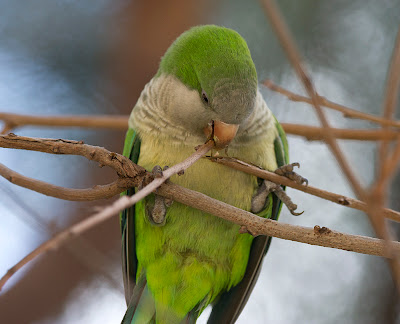Birding in Athens National Garden, right at the heart of the city behind Syntagma Square, can be exciting if you are hanging around downtown. Avifauna is thriving in the dense foliage, nesting, feeding or just being hidden inside the numerous plants.
Many species of birds enjoy the dense foliage of the park, including breeding Robins and Blue Tits (the latter not being found nesting anywhere else in Athens!).
Join us in a 2 hour birding walk at the National Garden of Athens
 |
| Monk Parakeets collect twigs for their nests |
 |
| Ring-necked Parakeets are fond of the fruits at Athens National Garden |
Athens National Garden has a very lush vegetation, consisting of centuries-old trees and bushes. Therefore, avifauna is thriving in the dense foliage, nesting, feeding or just being hidden inside the numerous plants.
Athens National Garden, Syntagma Square
Birding Athens National Garden during migration can be surprisingly productive, with Nightingale, Cuckoo, flycatchers, Golden Oriole, Wryneck
Birding and Photography Tips for the National Gardens
Choose the Right Time: Early morning or late afternoon are the best times to visit, as birds are more active during these cooler hours.
Bring Binoculars and a Telephoto Lens: A telephoto lens with a focal length of at least 300mm will help capture those distant, hidden species.
Be Patient and Listen: Many of the garden’s birds, especially warblers and robins, are often heard before they’re seen. Take your time, listen for distinctive calls, and move slowly.
Shoot at Higher ISO: Since the lighting is low, don’t be afraid to experiment, as modern cameras handle higher ISO quite well.
Focus on Behavior: Rather than waiting for the perfect perch shot, try capturing birds in action—feeding, preening, or flying. These natural behaviors make for more dynamic and engaging images.
Spyros Skareas
Bird Guide and Certified Tour Leader
Athens, GREECE








